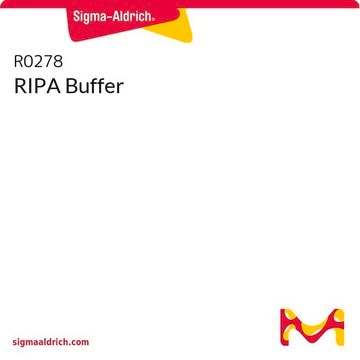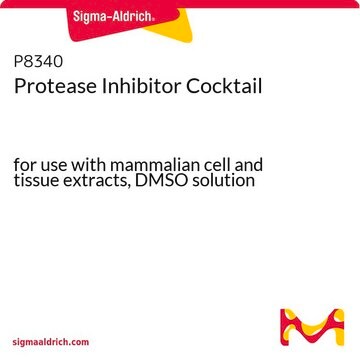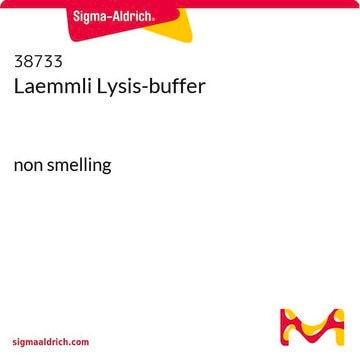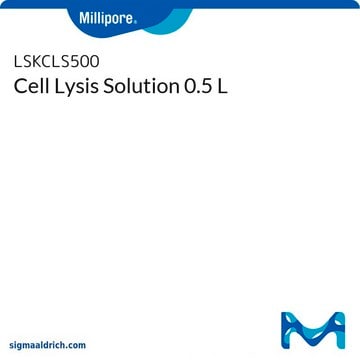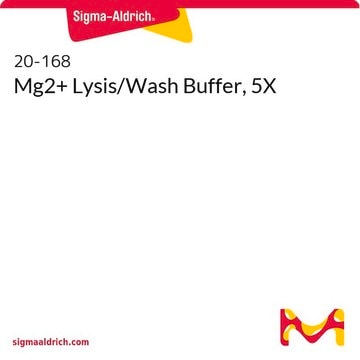Freeze-thaw cycles may lead to degradation of added phosphatase and protease inhibitors. It is highly recommended to prepare the cocktail just prior to application.
20-188
Tampon de lyse RIPA, 10X
100 mL RIPA Lysis Buffer, 10X for Immunoprecipitation & Western Blotting.
Synonyme(s) :
lysis buffer
Sélectionner une taille de conditionnement
153,00 $
Date d'expédition estimée le03 février 2025Détails
Sélectionner une taille de conditionnement
About This Item
153,00 $
Date d'expédition estimée le03 février 2025Détails
Produits recommandés
Forme
liquid
Conditionnement
pkg of 100 mL
Fabricant/nom de marque
Upstate®
Technique(s)
immunoprecipitation (IP): suitable
western blot: suitable
Conditions d'expédition
ambient
Description générale
Application
Forme physique
Stockage et stabilité
Autres remarques
Informations légales
Clause de non-responsabilité
Mention d'avertissement
Danger
Mentions de danger
Conseils de prudence
Classification des risques
Aquatic Chronic 3 - Eye Dam. 1
Code de la classe de stockage
10 - Combustible liquids
Classe de danger pour l'eau (WGK)
WGK 3
Certificats d'analyse (COA)
Recherchez un Certificats d'analyse (COA) en saisissant le numéro de lot du produit. Les numéros de lot figurent sur l'étiquette du produit après les mots "Lot" ou "Batch".
Déjà en possession de ce produit ?
Retrouvez la documentation relative aux produits que vous avez récemment achetés dans la Bibliothèque de documents.
Les clients ont également consulté
-
Can I prepare 10 ml of 1x RIPA buffer and add phosphatase and protease inhibitor then aliquot it to 1 ml Eppendorf tubes and store at -20 for use?
1 answer-
Helpful?
-
-
Can this lysis extract protein from the Nucleus?
1 answer-
RIPA Buffer enables the extraction of cytoplasmic, membrane, and nuclear proteins. Certain proteins are more soluble in RIPA buffer than others.
Helpful?
-
-
How long can 1x RIPA lysis buffer be stored with or without the protease?
1 answer-
This product is stable at room temperature for 6 months from date of shipment. Protease and phosphatase inhibitors should be added immediately prior to use.
Helpful?
-
-
I used the 10X RIPA buffer to lyse my cultured cells. How can I do next? Will it affect the protein quantification by using BCA assay kit? Also, will it affect the SDS-PAGE and Western blot?
1 answer-
Protein samples prepared from cell culture lysates using this 1X RIPA buffer are typically compatible with downstream applications such as BCA assay, SDS-PAGE, and Western blotting. The concentrations of salts and detergents present in the 1X RIPA buffer are relatively low, minimizing interference with these techniques.
Helpful?
-
-
Can we store it a 4 degree, if we want to use it after 6 months?
1 answer-
Studies have not been performed to determine if refrigerated storage will extend the shelf life of this product. The end user would have to determine suitability if used after the recommended 6 months. Note that product R0278, a 1X Ripa Buffer, is stored refrigerated and includes a warranty of 1 year from the date of shipment. Please see the link below to review this product datasheet:
https://www.sigmaaldrich.com/deepweb/assets/sigmaaldrich/product/documents/350/775/r0278bul.pdfHelpful?
-
-
Someone in lab left the 10X RIPA Buffer in room temperature for overnight. Will it affect the quality of the buffer? Could we continue to use it?
1 answer-
This product does not require refrigeration and is stable at room temperature for up to 6 months.
Helpful?
-
-
Do I used distilled water to dilute to 1X?
1 answer-
The 10X RIPA Lysis Buffer should be diluted with nine parts sterile, distilled water.
Helpful?
-
-
Do I have to dilute to 1X for protein isolation?
1 answer-
Yes, RIPA lysis buffer should be diluted to 1X prior to use.
Helpful?
-
Active Filters
Notre équipe de scientifiques dispose d'une expérience dans tous les secteurs de la recherche, notamment en sciences de la vie, science des matériaux, synthèse chimique, chromatographie, analyse et dans de nombreux autres domaines..
Contacter notre Service technique